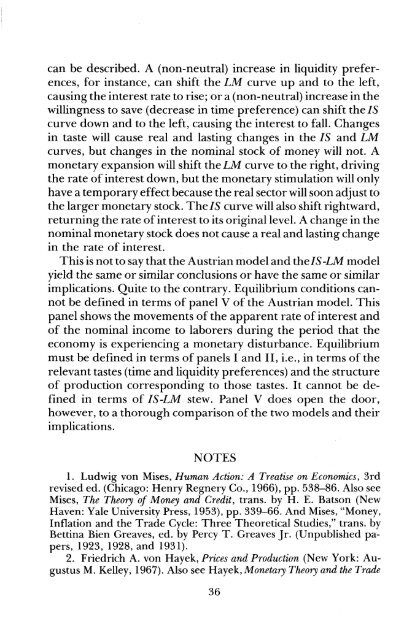Austrian Macroeconomics - Ludwig von Mises Institute
Austrian Macroeconomics - Ludwig von Mises Institute
Austrian Macroeconomics - Ludwig von Mises Institute
You also want an ePaper? Increase the reach of your titles
YUMPU automatically turns print PDFs into web optimized ePapers that Google loves.
can be described. A (non-neutral) increase in liquidity preferences,<br />
for instance, can shift the LM curve up and to the left,<br />
causing the interest rate to rise; or a (non-neutral)increase in the<br />
willingness to save (decrease in time preference) can shift the IS<br />
curve down and to the left, causing the interest to fall. Changes<br />
in taste will cause real and lasting changes in the IS and LM<br />
curves, but changes in the nominal stock of money will not. A<br />
monetary expansion will shift the LM curve to the right, driving<br />
the rate ofinterest down, but the monetary stimulation will only<br />
have a temporary effect because the real sector will soon adjust to<br />
the larger monetary stock. TheIS curve will also shift rightward,<br />
returning the rate ofinterest to its original level. A change in the<br />
nominal monetary stock does not cause a real and lasting change<br />
in the rate of interest.<br />
This is not to say that the <strong>Austrian</strong> model and theIS-LM model<br />
yield the same or similar conclusions or have the same or similar<br />
implications. Quite to the contrary. Equilibrium conditions cannot<br />
be defined in terms of panel V of the <strong>Austrian</strong> model. This<br />
panel shows the movements ofthe apparent rate ofinterest and<br />
of the nominal income to laborers during the period that the<br />
economy is experiencing a monetary disturbance. Equilibrium<br />
must be defined in terms of panels I and II, i.e., in terms of the<br />
relevant tastes (time and liquidity preferences) and the structure<br />
of production corresponding to those tastes. It cannot be defined<br />
in terms of IS-LM stew. Panel V does open the door,<br />
however, to a thorough comparison ofthe two models and their<br />
implications.<br />
NOTES<br />
1. <strong>Ludwig</strong> <strong>von</strong> <strong>Mises</strong>, Human Action: A Treatise on Economics, 3rd<br />
revised ed. (Chicago: Henry Regnery Co., 1966), pp. 538-86. Also see<br />
<strong>Mises</strong>, The Theory of Money and Credit, trans. by H. E. Batson (New<br />
Haven: Yale University Press, 1953), pp. 339-66. And <strong>Mises</strong>, "Money,<br />
Inflation and the Trade Cycle: Three Theoretical Studies," trans. by<br />
Bettina Bien Greaves, ed. by Percy T. Greaves Jr. (Unpublished papers,<br />
1923, 1928, and 1931).<br />
2. Friedrich A. <strong>von</strong> Hayek, Prices and Production (New York: Augustus<br />
M. Kelley, 1967). Also see Hayek, Monetary Theory and the Trade<br />
36

















